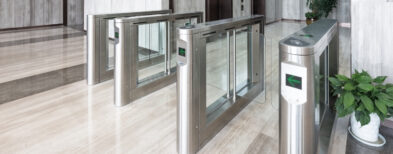Hospitals and healthcare facilities must prioritize security measures to protect patients, staff and sensitive medical data. This is where cloud-based access control solutions have emerged as a game-changer. By harnessing the power of the cloud, hospitals can enhance their security protocols and ensure the safety of their premises. Not only can hospital IT and security administrators protect the people in their buildings, but they can also make sure protected health information (PHI) and personally identifiable information (PII) stays secure. Let’s explore the importance of hospital access control and the role of cloud security systems.
What is Hospital Access Control?
Hospital Access Control is a type of physical security that permits and restricts people from entering specific areas within a hospital or healthcare facility. These systems operate using credentials and credential readers. Such devices include physical key cards, mobile devices with digital access credentials or biometric access control. When a card is scanned against a card reader, the system authenticates the user’s credentials, and the door unlocks.
Access control systems act as the first line of defense in healthcare facility security. These systems allow authorized individuals to gain entry while preventing unauthorized access. By implementing access control, hospitals can better manage access to different areas, such as patient rooms and drug storage units.
The Role of Access Control in Hospital Security
Hospitals and healthcare facilities are unique environments with diverse stakeholders, including patients, healthcare providers and support staff. Ensuring the safety of everyone within the premises is of paramount importance. From protecting patients’ privacy to safeguarding expensive medical equipment, hospitals face many security challenges. Therefore, robust access control measures are vital to maintain a secure and welcoming environment for all.
Current Challenges in Healthcare Access Control
Despite the pressing need for patient safety, hospitals often encounter challenges in maintaining effective physical security. One common challenge is the frequent movement of personnel within the hospital setting. Staff members, doctors, and healthcare providers require access to different areas at various times, making it difficult to manage access rights.
Moreover, hospitals face the constant threat of theft both internally and externally. Expensive medical equipment, pharmaceuticals and valuable data are attractive targets for potential intruders. Traditional security systems often fail to provide the level of control and monitoring required to mitigate these risks.
Additionally, compliance with stringent healthcare regulations, such as HIPAA (Health Insurance Portability and Accountability Act), is a significant challenge. Hospitals need to ensure that patient data is protected and accessed only by authorized individuals. Cloud-based access control can assist in meeting these compliance requirements by providing robust access management and audit capabilities.
What is Cloud-Based Access Control?
Traditional security systems often struggle to address the dynamic nature of hospitals. Outdated key-based access control systems or can be cumbersome and time-consuming to manage. In addition, these systems do not provide the necessary audit trails and real-time monitoring capabilities. This is where cloud-based access control systems come into play.
Cloud-based access control systems use the internet to connect various access points and control panels to a centralized cloud platform. This central platform acts as a control hub, allowing hospitals to manage access rights, generate detailed reports and monitor real-time activity across multiple locations.
Cloud-based access control systems go beyond traditional methods by leveraging the power of the cloud. These solutions provide a centralized platform for managing access rights, granting permissions, and monitoring activity in real time. With cloud-based access control, hospitals can not only enhance security but also streamline administrative tasks and reduce costs.
The cloud enables hospitals to store data and access control information securely, eliminating the need for on-premises servers and infrastructure. This technology offers several key benefits that positively impact hospital security.

Benefits of Using Cloud-Based Systems
Cloud-based access control brings numerous benefits to hospitals, enhancing overall security and streamlining operations:
- Scalability and Flexibility: Cloud-based systems allow hospitals to easily scale up or down their security infrastructure based on their needs. Whether adding new access points or integrating with existing systems, cloud-based solutions offer unparalleled flexibility.
- Remote Management: Access control systems based on the cloud can be managed remotely, allowing administrators to make changes, grant permissions and monitor activity from anywhere with an internet connection. This feature is especially valuable for multi-location hospitals.
- Real-Time Monitoring: Cloud-based systems provide real-time insights into access events, enabling security personnel to identify and respond to potential threats more efficiently. The ability to monitor and generate detailed reports enhances proactive security measures.
- Cost-Effectiveness: By eliminating the need for physical infrastructure and on-premises servers, cloud-based access control reduces hardware and maintenance costs. Hospitals can allocate resources to other critical areas while enjoying the benefits of a sophisticated security system.
Implementing Cloud-Based Access Control
Transitioning to cloud-based access control requires careful planning and execution. Hospitals must consider various factors to ensure a smooth implementation process and maximize the system’s potential benefits.
Key Considerations for Implementation
Before implementing cloud-based access control, hospitals should:
- Conduct a Security Audit: Hospitals should assess their existing security infrastructure and identify areas that require improvement. This audit will help determine the specific requirements and goals of the cloud-based access control system.
- Collaborate with Stakeholders: Involving all relevant stakeholders, including administrators, IT teams, and security personnel, is crucial for a successful implementation. Effective collaboration ensures that everyone’s needs and concerns are addressed, leading to a smoother transition.
- Perform Risk Assessment: Hospitals must evaluate potential risks and vulnerabilities in their security systems to develop effective risk mitigation strategies. Understanding the threats beforehand allows for appropriate system configuration and monitoring.
Steps to Transition to Cloud-Based Access Control
The implementation process for cloud-based access control involves the following steps:
- Planning: Define the project scope, determine the timeline, and set realistic goals and expectations. Create a comprehensive implementation plan that includes tasks, resources, and milestones.
- Integration: Evaluate existing security infrastructure and identify areas that can be integrated with the cloud-based system. Ensure the compatibility of new and existing components to guarantee seamless operations.
- Training and Adoption: Provide thorough training and support to all users to ensure a smooth transition. Familiarize them with the new system’s features, functionality, and best practices to maximize benefits.
- Ongoing Evaluation and Enhancement: Continuously monitor the system’s performance, gather feedback, and identify areas for improvement. Regularly update and optimize the system to adapt to evolving security needs.
Future of Hospital Security
As technology continues to advance and hospitals recognize the need for tighter security measures, cloud-based access control systems will shape the future of hospital security in significant ways.
Predicted Trends in Hospital Security
Experts anticipate the following trends in hospital security:
- Integration with IoT (Internet of Things): Cloud-based access control will seamlessly integrate with other IoT devices and systems, enhancing overall security and automation.
- Biometric Authentication: Advanced biometric authentication methods, such as fingerprint or facial recognition, will further strengthen access control, ensuring the highest level of security.
- Artificial Intelligence (AI)-Powered Analytics: AI-based analytics will play a crucial role in proactive threat detection and predictive security in hospital environments, enabling timely response and risk mitigation.
Cloud-based access control helps hospital security by:
- Enhancing Overall Security: Cloud-based systems offer advanced features, such as automated alerts, real-time monitoring, and granular access control, ensuring hospitals stay one step ahead of potential threats.
- Streamlining Operations: By automating previously manual tasks, cloud-based access control saves time and resources, allowing healthcare providers to focus on delivering superior patient care.
- Promoting Compliance: Strict adherence to healthcare regulations, such as HIPAA, is crucial. Features like audit trails help IT and security teams adhere to security policies and procedures.
Though securing hospitals is an ongoing challenge, leveraging technology can help. Cloud-based access control offers hospitals a powerful tool to enhance security protocols, streamline operations and adapt to evolving threats. With the cloud, hospitals can stay at the forefront of the ever-evolving healthcare landscape while ensuring the safety and well-being of patients, staff and critical data.



